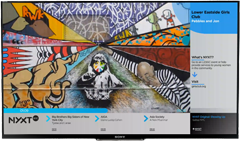Supporting creative people and protecting their ideas is vital in times like now where we need to find new ways to take care of each other. The art+tech organization Eyebeam is acting fast through its Rapid Response for A Better Digital Future program, incentivizing artists to submit proposals for projects that will create alternative spaces to keep on producing critical and radical thinking. We recently spoke with Roderick Schrock, Eyebeam’s Executive Director, to learn more about the vision the organization has about this new program, which is receiving applications until May 21st.
How are Eyebeam and its community being affected by the pandemic?
I’ve been actively listening to our artist community every Friday afternoon at 2 pm, during our Open Hours, and what I’ve heard is that artists want to think big at this moment when it feels like the world is falling apart. That isn’t saying that artists should be solving the world ‘s problem, but that the community of artists that are thinking about this moment, cross-disciplinary, from the perspective of technology, education, social sciences, and policy, that this is a moment of taking stock and allowing for deep imagination. They are being impacted deeply, and I think artists are essential workers -- we need them because they help us transform our interiority, to come to a different place in our conception of ourselves in the world. But they need support at this time, more than ever because many of them are suffering just as much as other sectors, particularly in light of the art market and gallery world grinding basically to a halt.
What is the Rapid Response for A Better Digital Future program? How does it work? Who are some of the individuals involved? Are you collaborating with other groups on this program?
This is a program that I conceived of, in dialogue with a stellar group of advisers, as a response to my total inability to conceive of what an artist residency program is at this time. To have something that is so based on interaction in physical space as a residency, as well as tool usage and studio work, just felt like an unknown quantity. So, knowing what artists were needing, funding, and support to do work on imagining the next 10 years, not just the next 10 days, felt like the right direction to go. So we’re doing that, through the creation of a virtual research and development Lab.
In your notes for this program, it says “The guiding question for this call is ‘how do we begin to exit surveillance capitalism as the dominating form of digital life and what can replace it?’” Can you explain why you are suggesting that inquiry? What type of problems are you trying to solve?
Eyebeam starts with art: ideas, concepts, aesthetic intentionality. So, in that sense, we’re not trying to problem solve. But what we are doing is to model what it could look like for a non-profit organization that works to put visionary work into the public domain to support, firstly, ideas, then for those ideas that have the potential for kineticism in the larger culture and are stretching into projects, let’s give them an even larger level of support to make that a reality. We started with a focus on surveillance capitalism as the guiding question because Hito Steyerl rightly suggested that all of the other issues be framed in relationship to that -- because at the end of the day, this is the most obscure corner of our society’s spiritual life, if you will: how our personal identity and information are being commodified, and artists are good at shining light on things we don’t normally think about. Eyebeam is suggesting, hey, let’s think about this.
Could you share examples of projects with a similar perspective selected in some of Eyebeam’s previous open calls?
I think the work of Stephanie Dinkins and her performance pieces in dialogue with the “world’s most emotionally advanced AI” Bina48 is a great example of an artist tackling societal issues, and shining light on the things getting missed. Such as, what are the specific impacts of emerging technologies on African-American communities? Another example would be the journalistic investigation of Michael Mandiberg, who researched the reality of who Wikipedia editors are throughout the country, and how that correlates to specific social, demographic, and economic markers.
Photo via eyebeam.org
As an arts administrator, what would you say is your responsibility and input about these issues?
My role, as an arts administrator, is to create conditions for creativity, for the artists making the work. To provide connectivity and support, and to make sure we do so in a way that is equitable and as financially generous as possible.
Eyebeam has a radical way of working, asking questions about contemporary problems through art and technology. What organizations/leaders/designers/philosophers are you interested in and inspired by?
Two books that were very influential in my thinking around crafting this open call were McKenzie Wark’s “Capitalism Is Dead” and John Maeda’s “How To Speak Machine”. They’re completely different, but reading them simultaneously opened my mind to both the intensity and scale of information instrumentalization as well as the unfathomable scope and scale of machine learning that is one or two years down the road. Taken together, they were quite the wake-up call!
Subscribe to the NYXT newsletter
Learn about upcoming events, volunteer opportunities, and new organizations looking for your help.


